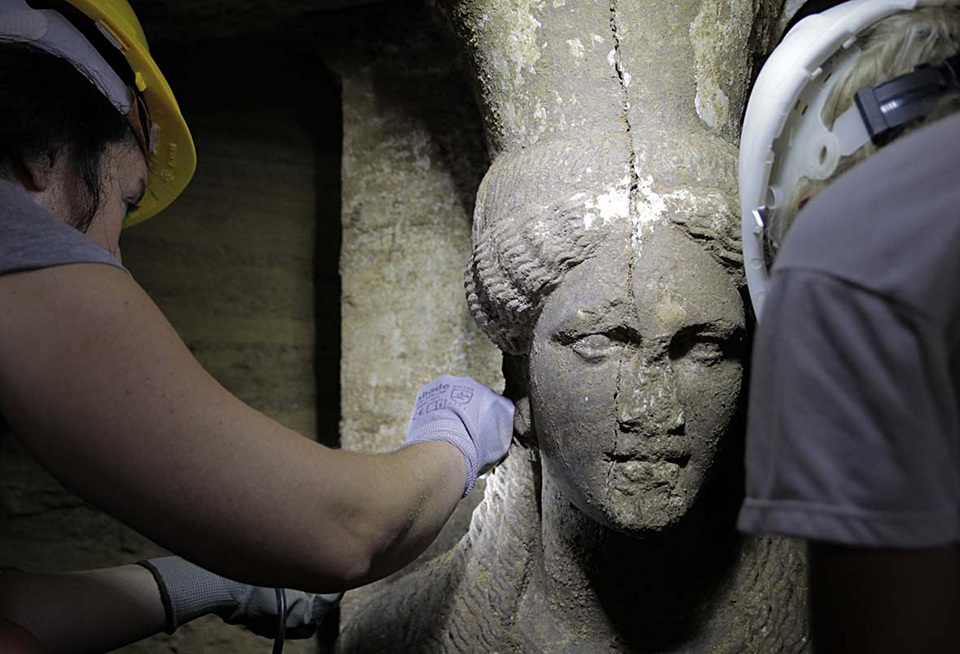Filtered By: Lifestyle
Lifestyle
Mystery of Alexander the Great-era tomb holds Greeks in thrall
By RENEE MALTEZOU and DEEPA BABINGTON, Reuters

This handout picture released by the Greek Ministry of Culture on September 7, 2014 shows one of the two statues of a Caryatid—a half-bodied marble female statue serving as architectural support—inside the Kasta Tumulus in ancient Amphipolis, northern Greece. The excavations at the ancient tomb of Amphipolis uncovered two Caryatids. AFP PHOTO/Greek Ministry of Culture
In a land with one of the world's richest cultural heritages, archaeologists rarely receive much public notice. Yet Peristeri has become the face of the Amphipolis crypt, a 2,300-year-old sepulcher beneath the sandy hills of northern Greece. She has received three Greek awards in the past month alone.
"I'm just a simple archaeologist, doing my duty," she beamed at one prize ceremony. At another, she joined a choir in a rousing ode to Alexander's homeland.
The tomb may be the last resting place of Alexander's wife Roxane, his mother Olympias, or one of his generals, according to competing theories. But the speculation is not the only thing fuelling Peristeri's popularity.
After six years of economic crisis, political tumult and a humiliating international bailout, Greeks are desperate for heroes and Prime Minister Antonis Samaras's government is eager for some good news.
"It revives Greeks' hopes that despite their big struggle to survive there is a 'holy grail' that will reconnect them to a period of glory and power," said Christos Kechagias, a sociologist who teaches at the University of Athens. "In times of crisis, people have the chance to redefine their identity."
The popular television program "Anatropi," normally a political talk-show, has twice devoted its entire two-hour segment to the excavation. In a front-page spread, the Espresso tabloid suggested the identity of the tomb's mysterious resident could be divined with methods taken from the novels of Dan Brown. The answer, it said, lay in a painting by Renaissance master Giovanni Antonio Bazzi depicting Alexander's wedding.
Greek broadcasters have been transfixed by discoveries from the tomb—a pebble mosaic showing the abduction of Persephone; two sculpted "Caryatid" figures; skeletal remains in a limestone grave that are now being analyzed for identification.
"It's very unusual to have play-by-play coverage of archaeological work," said David Rupp, a classical archaeologist and director of the Canadian Institute in Greece. "It's almost become like a reality TV program."
Samaras has frequently highlighted the tomb in his speeches. With his wife Georgia, he toured the site in August, walking along the marble wall that rings the tomb. He then stood before the tomb's entrance guarded by headless sphinxes to announce a "significant discovery" that makes "all Greeks proud."
Hot pretzels
Stories on the Amphipolis tomb sell like hot "koulouri" or pretzels, the Kathimerini newspaper said. "It has unfolded in a thrilling way, never before has an archaeological excavation been unveiled this way," Culture Minister Constantinos Tassoulas told Greek television.
Not everyone is happy. The opposition has criticized Samaras—whose government handles all announcements related to the tomb—for trying to make political capital from the discovery.
"Amphipolis is not the place for political games," said Panos Skourletis, spokesman for the opposition Syriza party.
Despina Koutsoumba, an archaeologist who belongs to the small, anti-capitalist Antarsya party, says Samaras is using Amphipolis to hide cutbacks at archaeological and other sites: "They highlight Amphipolis to cover up the nation's bankruptcy."
A legion of tomb-related cartoons have emerged: one shows Samaras urging archaeologists to identify the deceased in order to make him pay a new property tax; another shows economists digging at Amphipolis in an effort to find elusive growth.
And some say that an excavation is not going to lift the fortunes of a country where over one in four is unemployed and household income has fallen by a third since the crisis began.
"The truth is we would all like this to be something big," said Garifallia Dedes, 40, a psychologist.
"But ultimately it's nothing more than an important discovery that brightens our gray days."
At Amphipolis, there are hopes the discovery will help the region prosper. The museum that attracted about 5 visitors each weekend now gets up to 2,000, says Anna Panagiotarea, spokeswoman for the excavations. Buses packed with tourists and school groups arrive at the site even though it is not open to visitors.
Thessaloniki channel TV 100's audience jumps from 3 percent to about 24 percent of viewers when a regular half-hour bulletin on Amphipolis is broadcast, she adds.
"Readers feel uplifted as a nation—this news boosts their confidence," said Michalis Alexandridis, director of popular northern papers Makedonia and Thessaloniki.
Peristeri, the archaeologist, is glad the tomb "reminds the world of Greece's cultural contribution," But she plays down the fuss. "The excavation has not changed my life," she said through a spokeswoman, declining to be interviewed ahead of a news conference this week.
"This is scientific work I've been doing for 35 years." — AFP
More Videos
Most Popular




